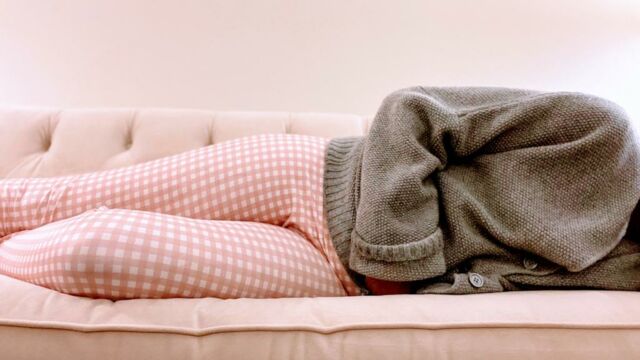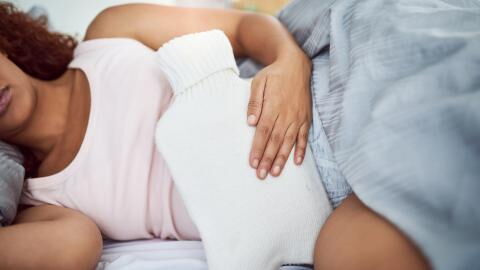Period cramps are a pain, and the worst can put you on bed rest for days. Nobody deserves to be doubled over every time they get their monthly. Luckily, there are a few ways you can get rid of your period cramps, and some methods will even help you beat them for good!
Discover our latest podcast
What are period cramps?
Period cramps are caused by contractions of the uterus that lead to pain and discomfort. These contractions occur when hormones signal the uterus to shed its endometrium each month. This is known as the menstrual phase of the menstrual cycle.
For many, period cramps are an inevitable part of menstruation, but how painful these cramps are dependant on the person. Those who are more prone to menstrual cramping include:
- People younger than 30
- People who experience a heavy flow
- People who experience irregular periods
- People who smoke
- People whose periods began at an early age
- People who have hormone disorders such as polycystic ovarian syndrome (PCOS)
- People on certain types of birth control
How to get rid of period cramps
There are numerous ways to relieve your period pain, but it may take some time to find out which works best for you.
1. OTC pain relievers
Common pain relievers like ibuprofen, panadol and aspirin are great at relieving period pain. For the best result, make sure you take pain killers at the first sign of cramping.
You can buy these pain relievers at any pharmacy or supermarket, but make sure you consult your doctor first if you have any underlying health conditions that this medication might affect.
2. Heat
Heat is an underrated form of period pain relief. If you are experiencing cramps, take a hot compress, wheat bag or hot water bottle and place it on your abdomen.
Even better, try picking up a heat patch or wrap from your local pharmacy, these patches can relieve muscle pain, and in one study, they proved to be more effective than OTC pain killers. The study also showed that heat pad users also experienced less PMS and mood swings.
3. Essential oil massage
Some studies suggest that an abdominal massage with essential oils may help to relieve period cramps. This is because some essential oils aid in circulation which can help with pain relief. While it is best to buy a blend of oils, you can get them individually and create your own.
The most effective essential oils for menstrual cramps include:
- Lavender
- Cinnamon
- Clove
- Marjoram
- Rose
- Sage
Most health food stores will sell essential oils, but you can also buy them online.
Before using an essential oil, make sure you have a carrier oil handy such as coconut, argan, almond, avocado, rosehip or jojoba oil. Essential oils can irritate the skin and cause allergic reactions and even burning. Using a carrier oil will help dilute the essential oil and alter the absorption rate, reducing the risk of irritation. Carrier oils also help spread your essential oils over a larger space.
To ensure you don’t have any adverse reactions to essential oils, it is best to patch test before use.
4. Yoga
Yoga can work wonders to reduce period cramps. While some poses help stretch the lower back and relieve pressure, the rush of endorphins and serotonin that yoga produces are the real pain killers. Relaxing poses such as child’s pose, reclined twist and adapted corpse poses are most well known for their powers to reduce period pain.
One small 2016 study also found that participants who completed just one hour of yoga once per week for 12 weeks saw a significant reduction in menstrual cramps. This means regular yoga practice may help reduce your period pain in the long run.
5. Epsom salt bath
If you’re looking for effective pain relief and a way to relax, then try an Epsom salt bath. Epsom salt baths have little scientific evidence behind them, but this magnesium soak is a common home remedy for easing muscle pain and reduce swelling.
When running an Epsom salt bath, a good measure is two cups of salt per standard bath size. You can even add in a few drops of essential oils for added aromatherapy benefits.
Epsom salt baths are generally considered safe; however, they may irritate some people’s skin, so it is a good idea to patch test first.
6. Exercise
Studies have shown that light aerobic exercise such as walking or swimming can help reduce menstrual cramping. This is because aerobic exercise not only increases blood flow but just like yoga, it releases endorphins that help reduce pain.
Regular aerobic exercise can also help reduce period cramping in the long term. A recent study found that those who engaged in 30 minutes of aerobic exercise three times a week for eight weeks reported a significant reduction in cramps.
7. Stay hydrated
You’re more likely to experience menstrual cramps if you’re dehydrated. Make sure you drink enough water each day, and it’s a good idea to stay away from beverages such as coffee and alcohol during your monthly.
8. Healthy diet
What you eat can also influence your hormones and inflammation and, therefore, the amount of period cramping you experience each month. Maintaining a diet high in fibre from vegetables, fruit, nuts, legumes, and whole grains will help to reduce menstrual pain in the long run.
One study has shown that a low fat, vegetarian diet also reduces cramping at that time of the month.
9. Acupressure
Acupressure is a non-invasive Chinese method that works by applying pressure to various points of the body to relieve several ailments, including period pain.
One popular trigger point for targeting period pain is known as the large intestine four (LI4) or Union Valley Point. This point is located on the back of your hand in the fleshy bit between the base of your thumb and index finger. All you need to do is apply pressure on this point and gently massage in a circular motion.
Another well-known pressure point is the Three Yin Crossing Point. This point was the successful subject of a recent study on period cramping and is located about three to four centimetres above the ankle bone towards the shin bone.
When to See a doctor
While period cramps are normal, severe cramps can be a sign of a serious problem. Suppose your period cramps are so painful that they disrupt your daily activities, or you start experiencing intensely painful period cramps after the age of 25. In that case, you’ll want to schedule an appointment with your doctor.
Intense period cramping can be a sign of some conditions such as:
- Endometriosis
- PCOS
- Pelvic inflammatory disease
- Sexually transmitted infections
- Uterine fibroids
- Adenomyosis















